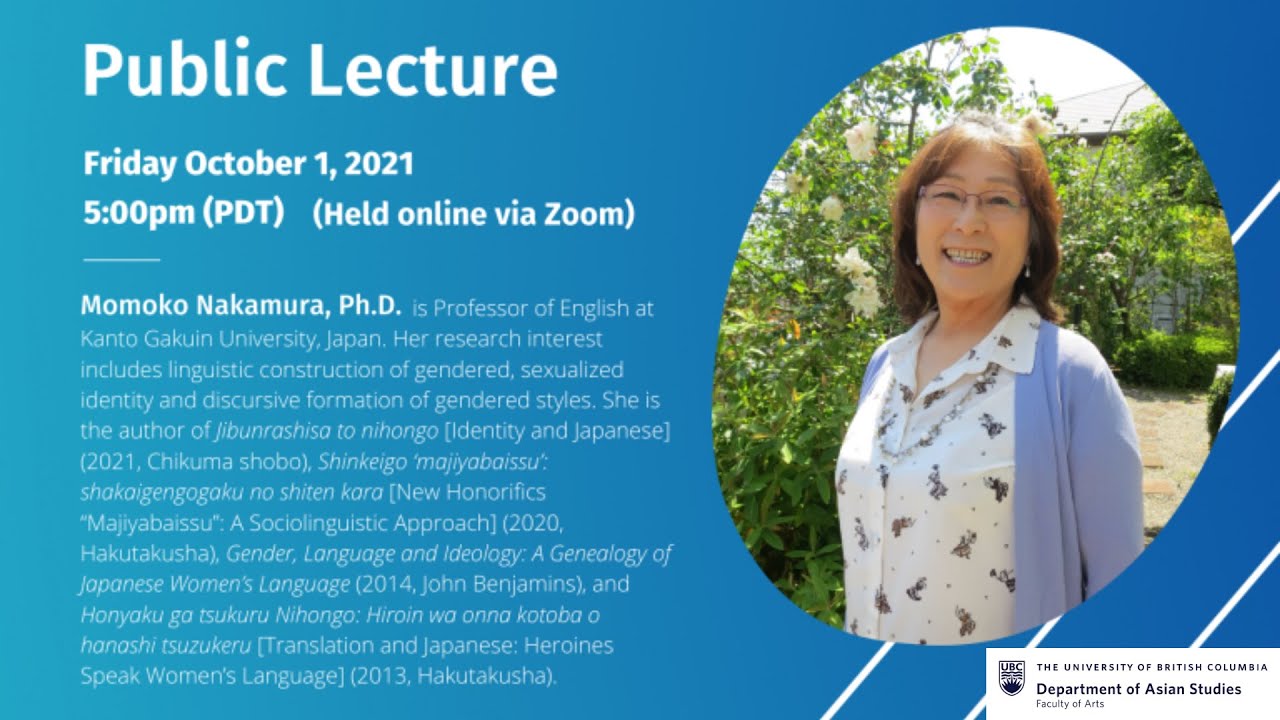Original summary:
UBC Asian Studies presents “Foreign Femininity and Masculinity in Japanese Translation,” held on October 1st, 2021 with professor and author Momoko Nakamura. This public lecture occurred as a component of JAPN465: Japanese Media and Translation. The talk was presented in English.
This paper investigates how Japanese translators use Japanese gendered features in translating the speech of non-Japanese women and men (Inoue 2003; Shibamoto Smith 2004). The data consists of the translated speech in English and Russian literary works, TV dramas, films and newspaper interview articles. Based on the methodology of discourse analysis, Dr. Momoko Nakamura examines the occurrences of feminine and masculine features in the wide range of media discourse (Nakamura 2013). The analysis shows: 1) Japanese translators overwhelmingly use feminine features in translating non-Japanese women’s speech, and 2) while they also employ masculine features in translating non-Japanese men’s speech, with respect to the casual, laid-back speech of non-Japanese men, they have created a specific Japanese style used only in the translation of the speech. The findings suggest: 1) the predominant use of feminine features for the speech of non-Japanese women works to naturalize Japanese femininity beyond linguistic and ethnic boundaries, and 2) the invention of the style for non-Japanese men serves to enregister the Japanese stereotype of non-Japanese casual masculinity, depending on which Japanese masculinity maintains its idealized status. In sum, this paper contributes to elucidating the inter-lingual intersections of gender construction.
Guest Speaker: Momoko Nakamura, Ph.D. is Professor of English at Kanto Gakuin University, Japan. Her research interest includes linguistic construction of gendered, sexualized identity and discursive formation of gendered styles. She is the author of Jibunrashisa to nihongo [Identity and Japanese] (2021, Chikuma shobo), Shinkeigo ‘majiyabaissu’: shakaigengogaku no shiten kara [New Honorifics “Majiyabaissu”: A Sociolinguistic Approach] (2020, Hakutakusha), Gender, Language and Ideology: A Genealogy of Japanese Women’s Language (2014, John Benjamins), and Honyaku ga tsukuru Nihongo: Hiroin wa onna kotoba o hanashi tsuzukeru [Translation and Japanese: Heroines Speak Women’s Language] (2013, Hakutakusha).



I guess the best answer for why that happens (non-japanese speech being translated as japanese gender stereotypes) is mainly because of cultural reasons and a bit of globalization. From a globalization point of view, many 80s famous movies were published in USA, where men teenagers are super cool, they go to parties and stuff, also they usually are main character or hero (in films), but that was not common (traditionally, at least) in Japan at 80s. Culturally, since kid japanese men learn that they need to be formal and employed for earning money to keep family billings okay while women raises kids. Speaking bad words or in a informal way to someone in a higher rank than you is unacceptable. In short, japanese needs to be pure, formal and honored, even more for women. So translating foreign movies (foreign movies = american movies only) were surprising for japanese translators at the time, because many characters were a bit too extroverted or offensive from a japanese perspective. The “Alien” example is extremely offensive for 80s japanese as women cannot act that way, otherwise they’d be execute in Samurai Era. For differentiating japanese from foreigners, translators adopted that norm.